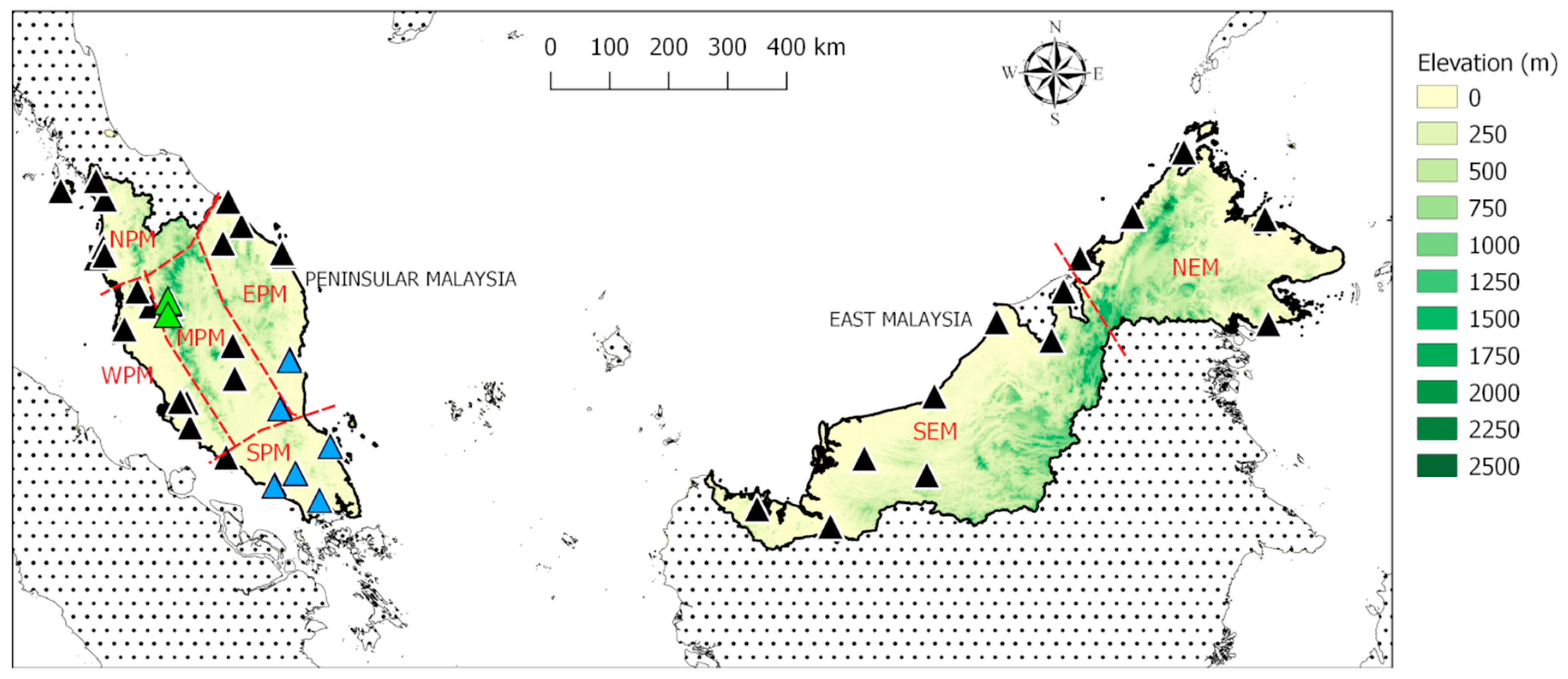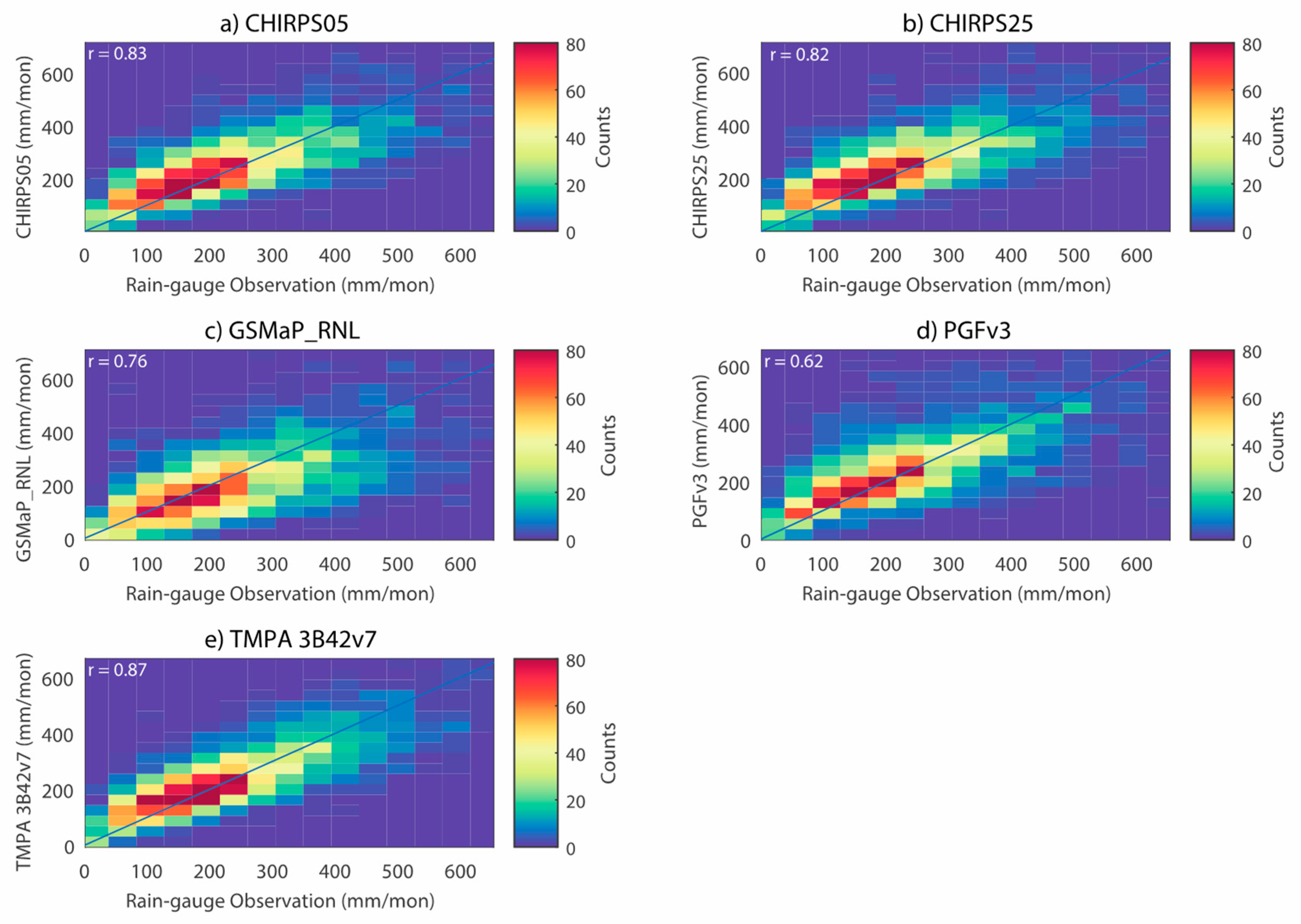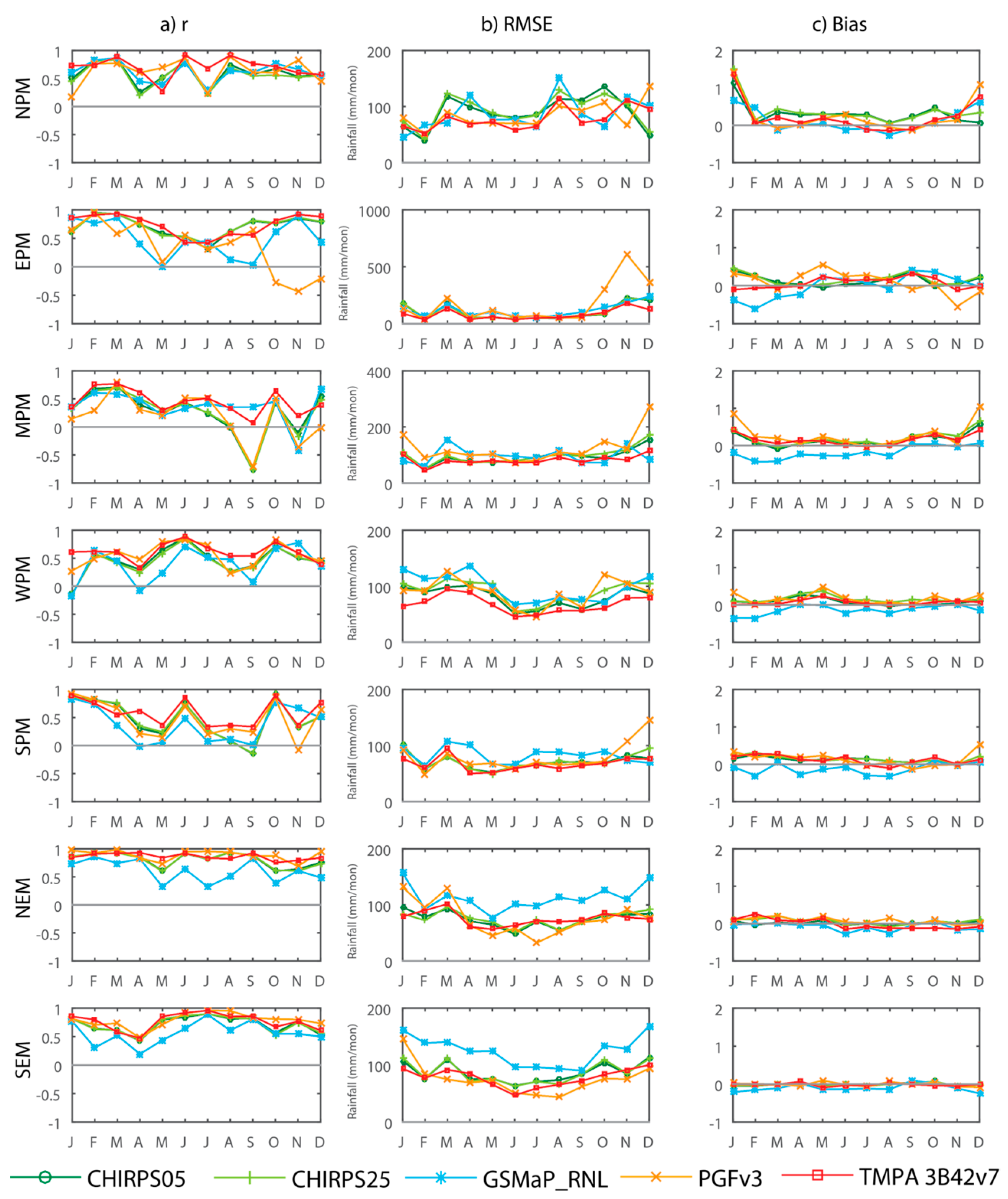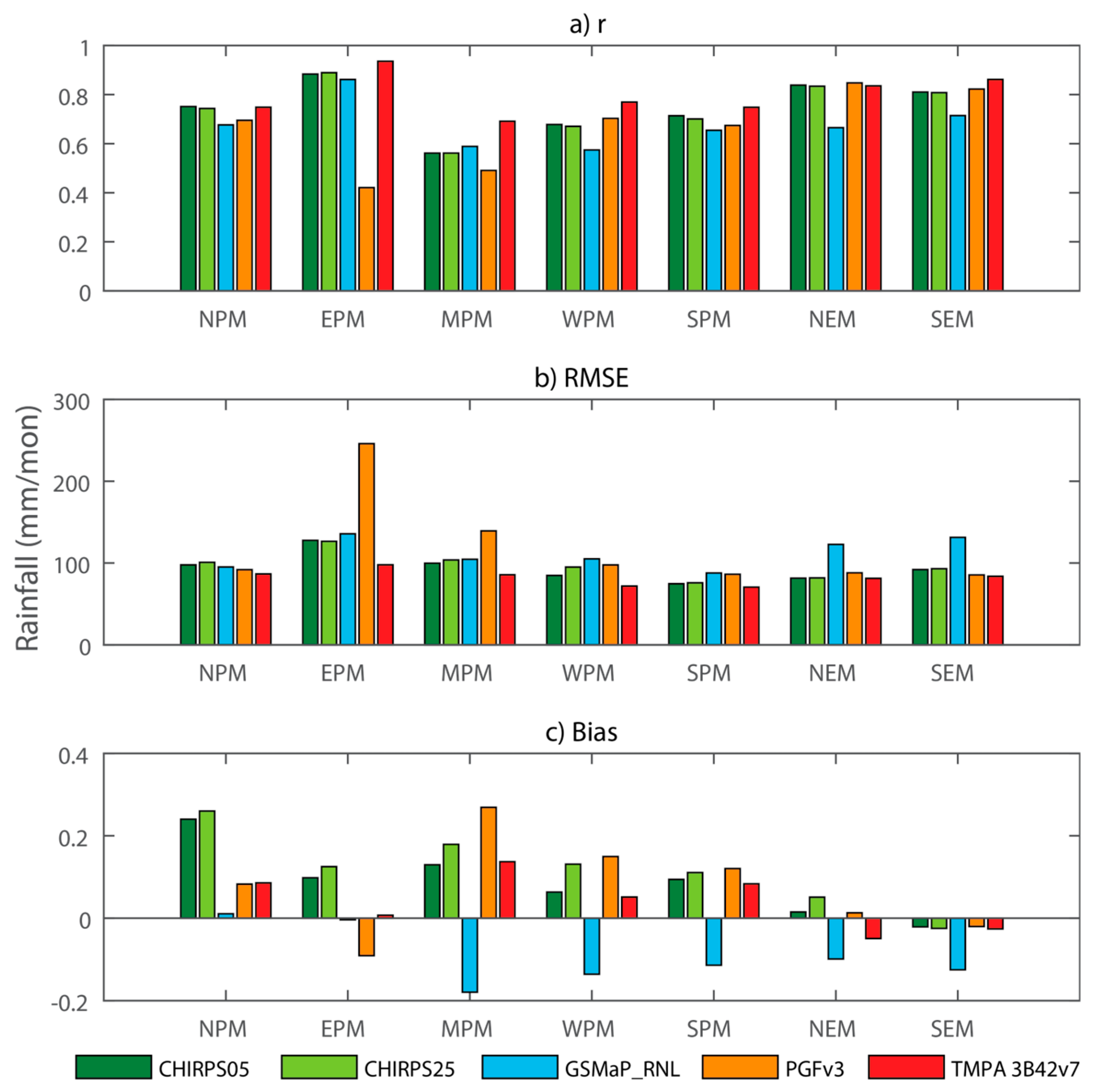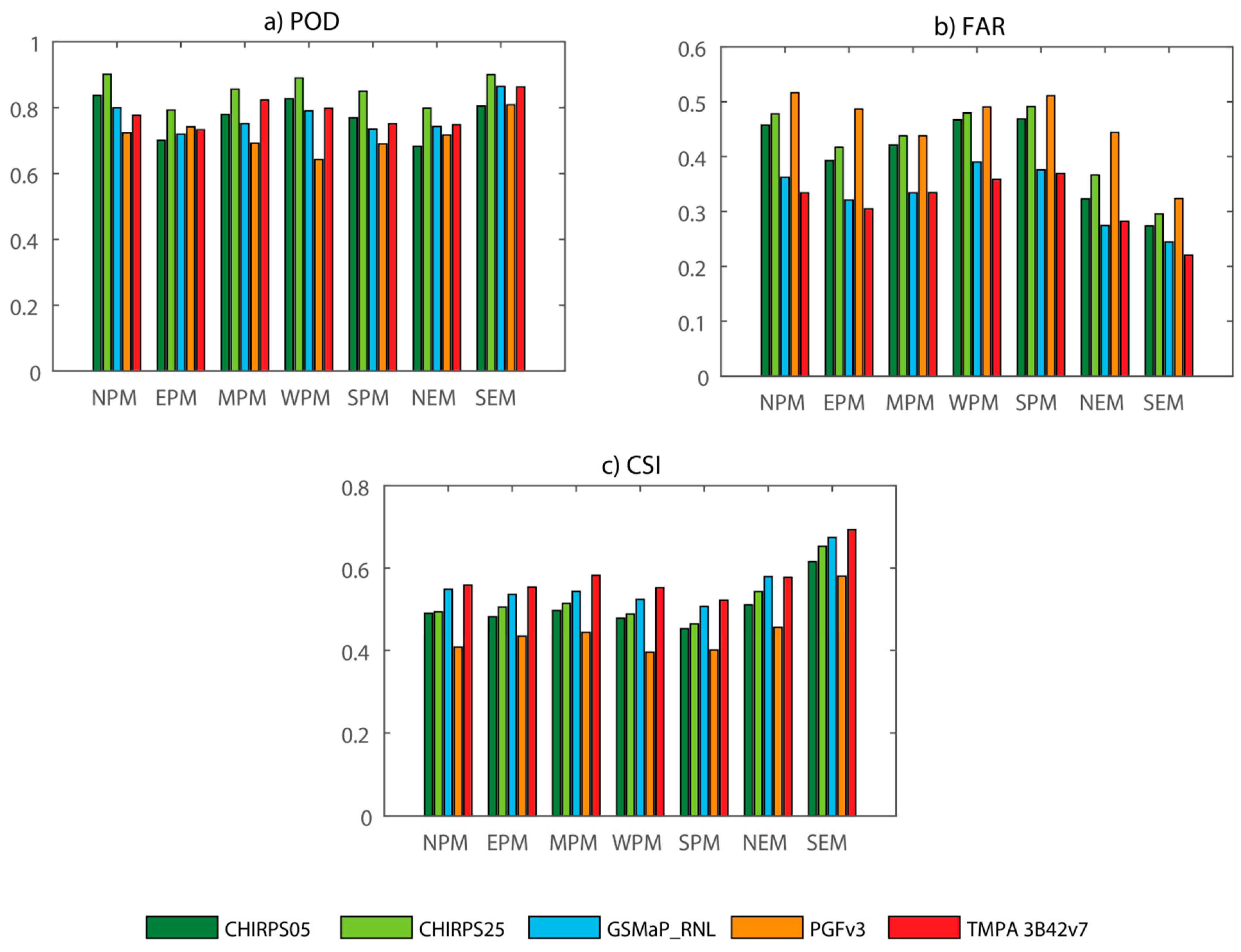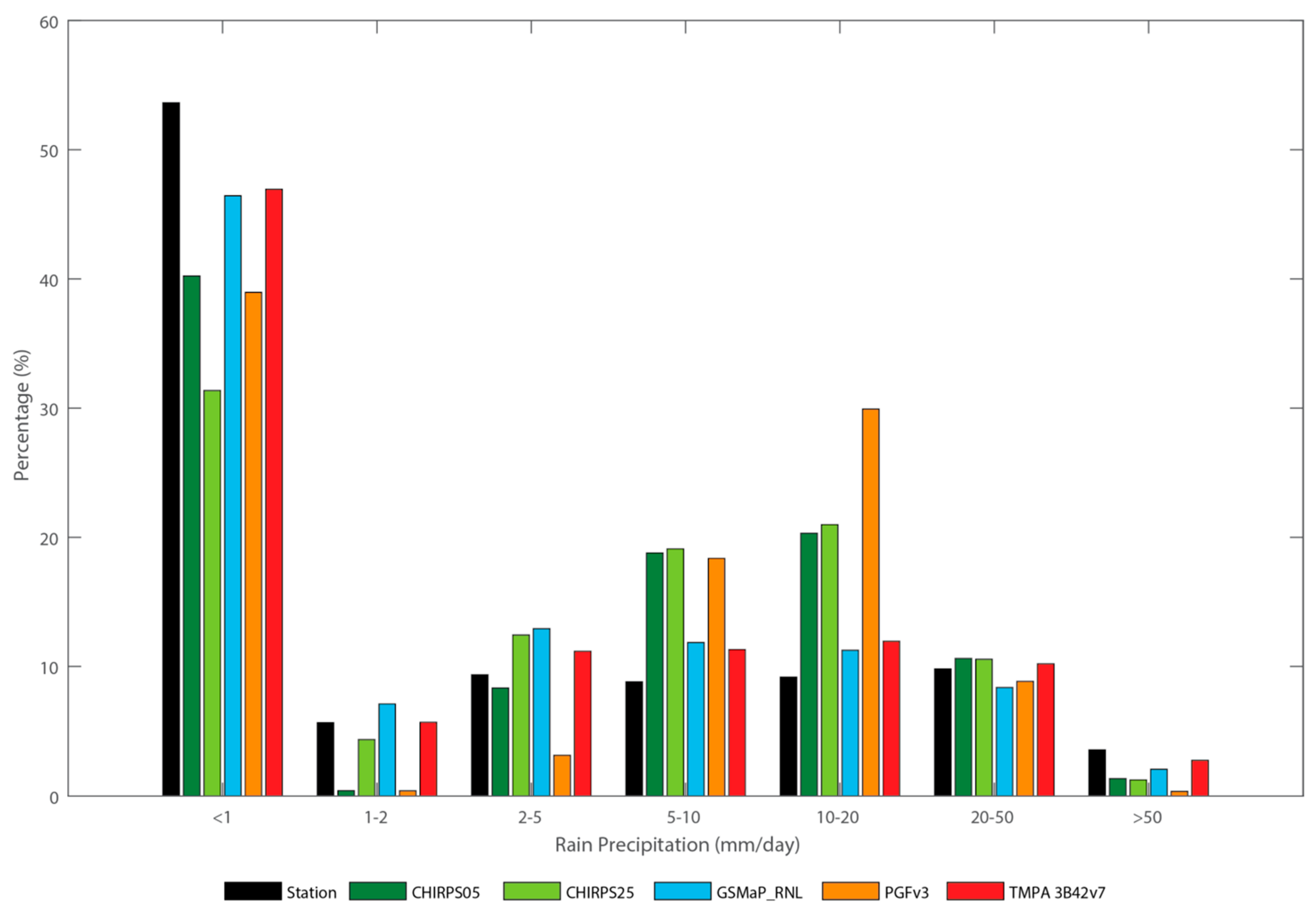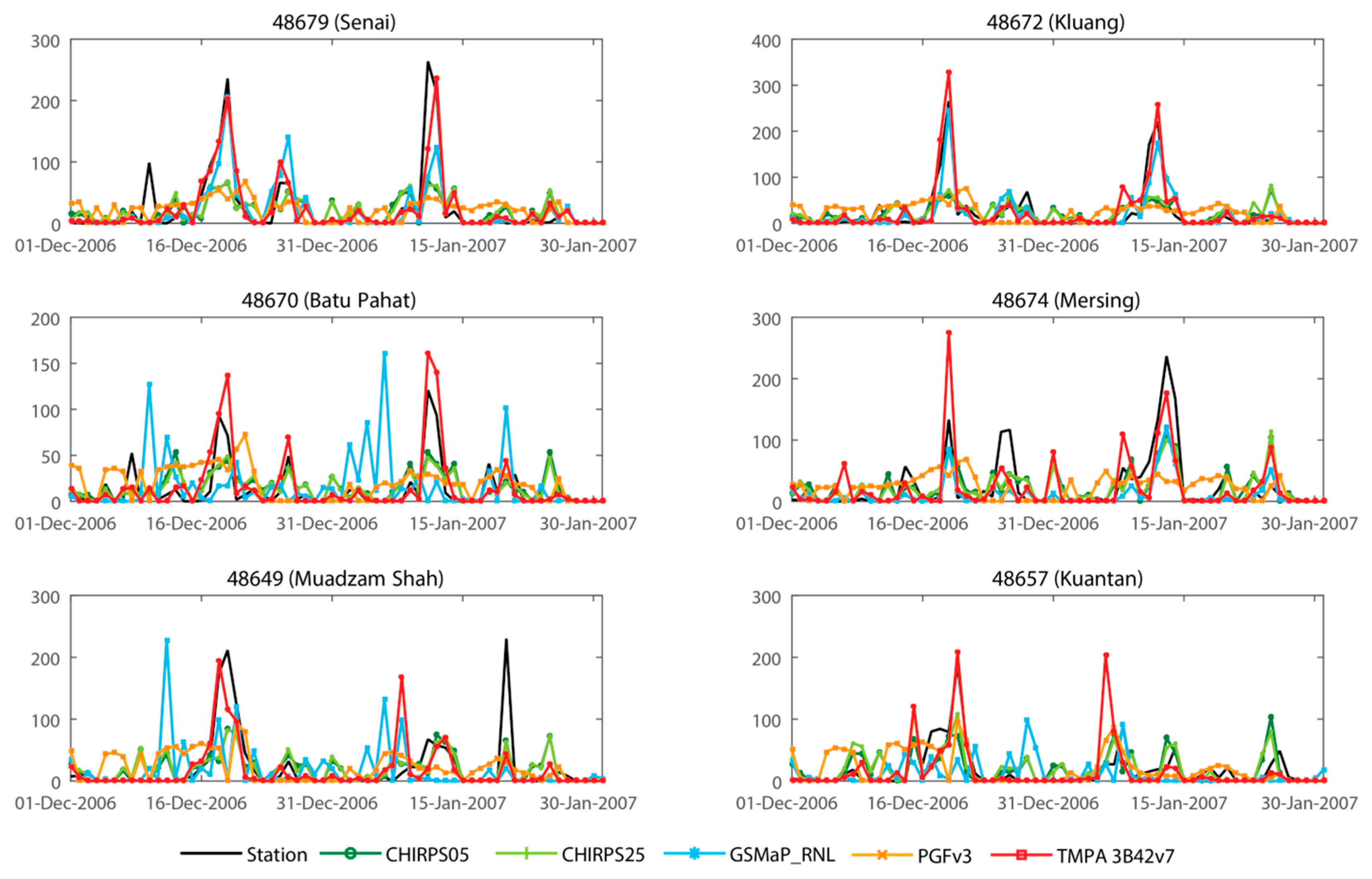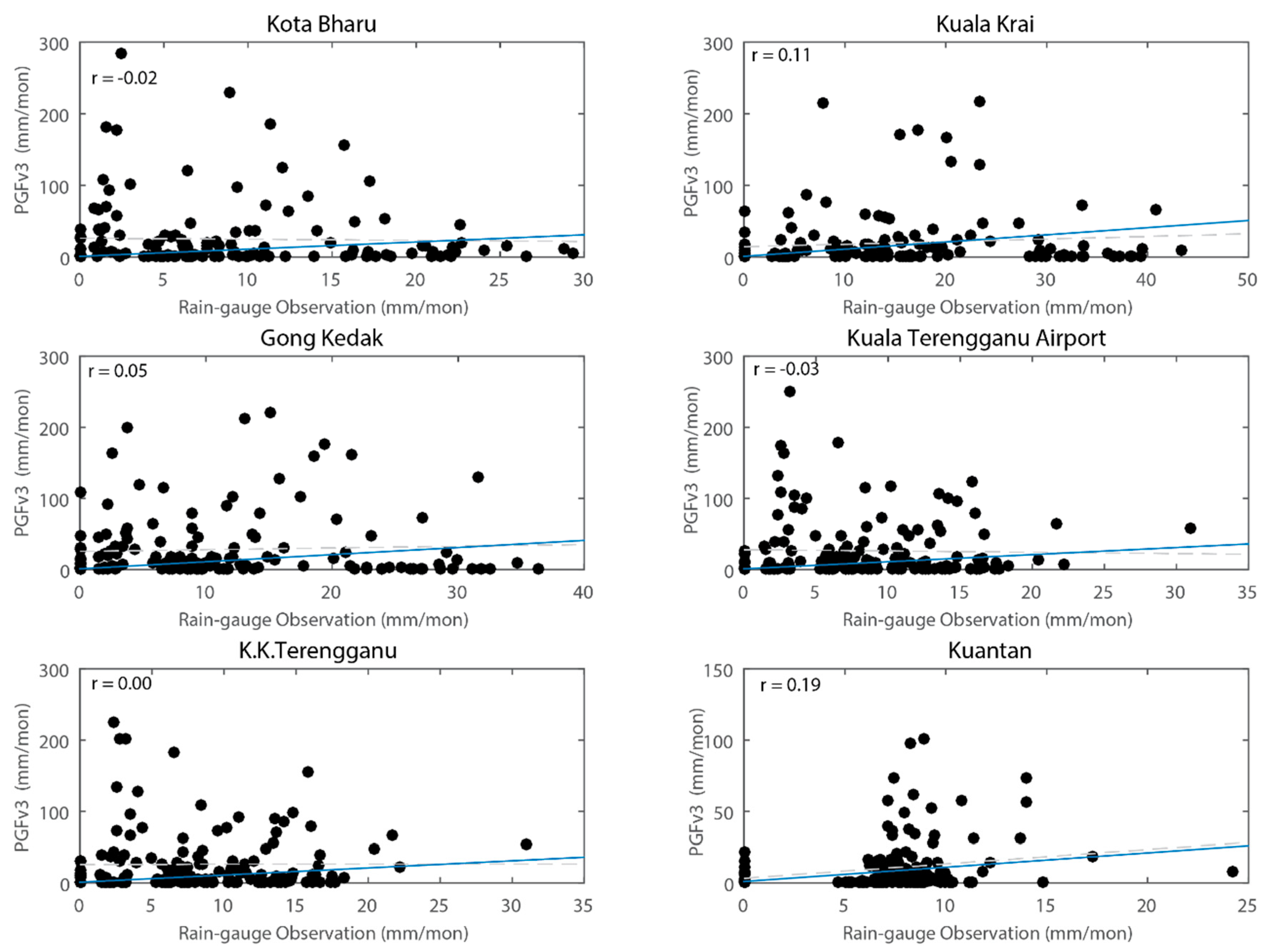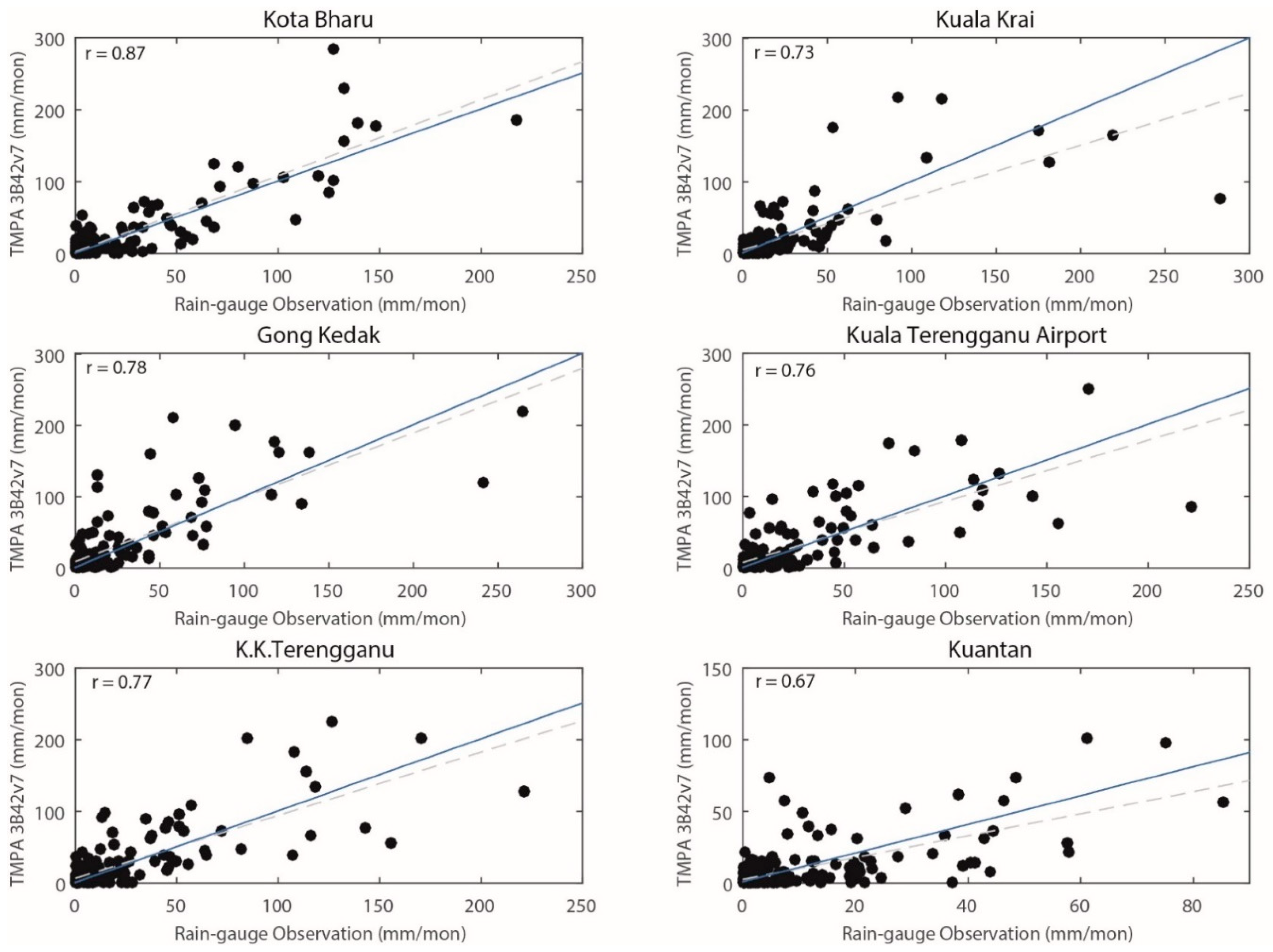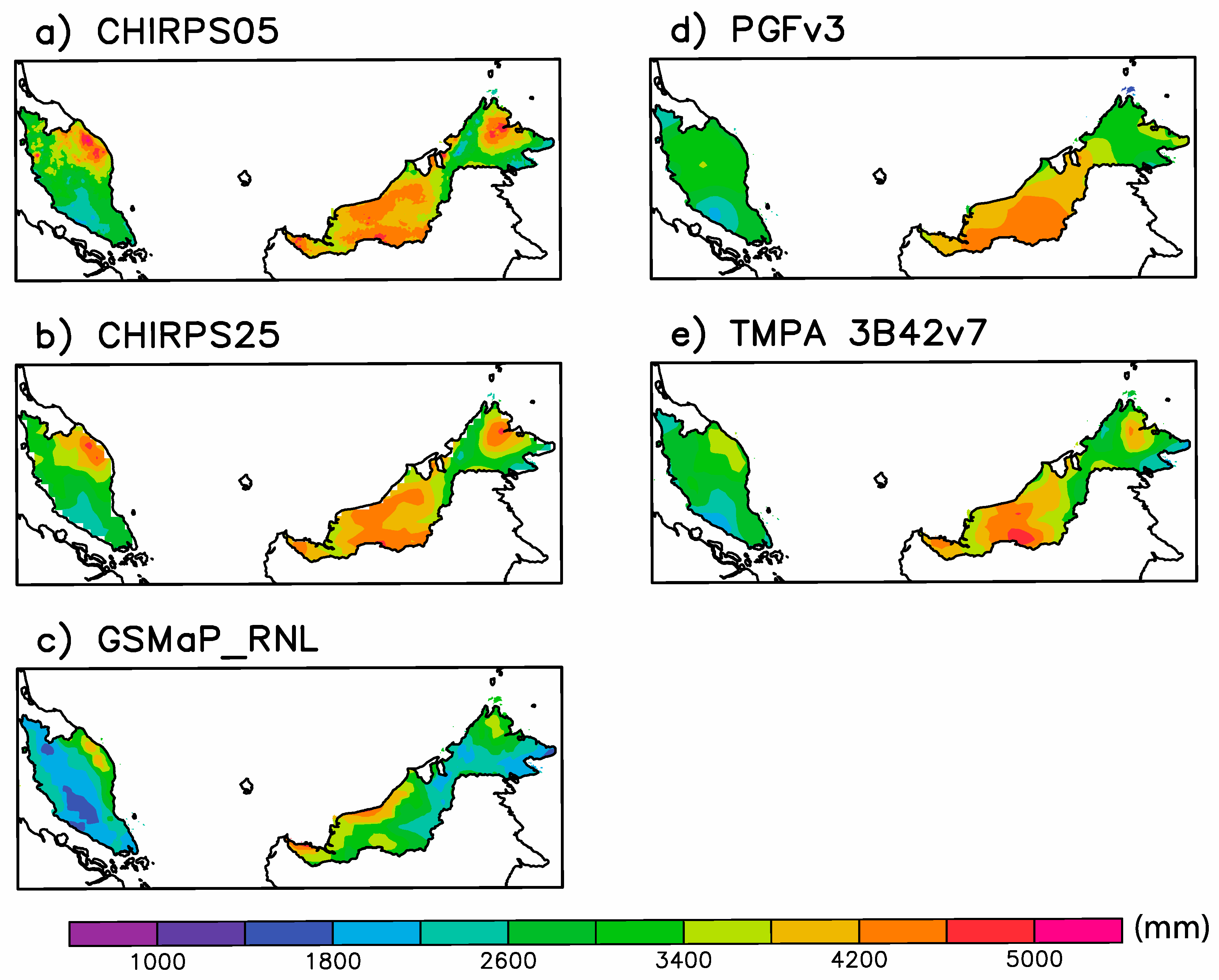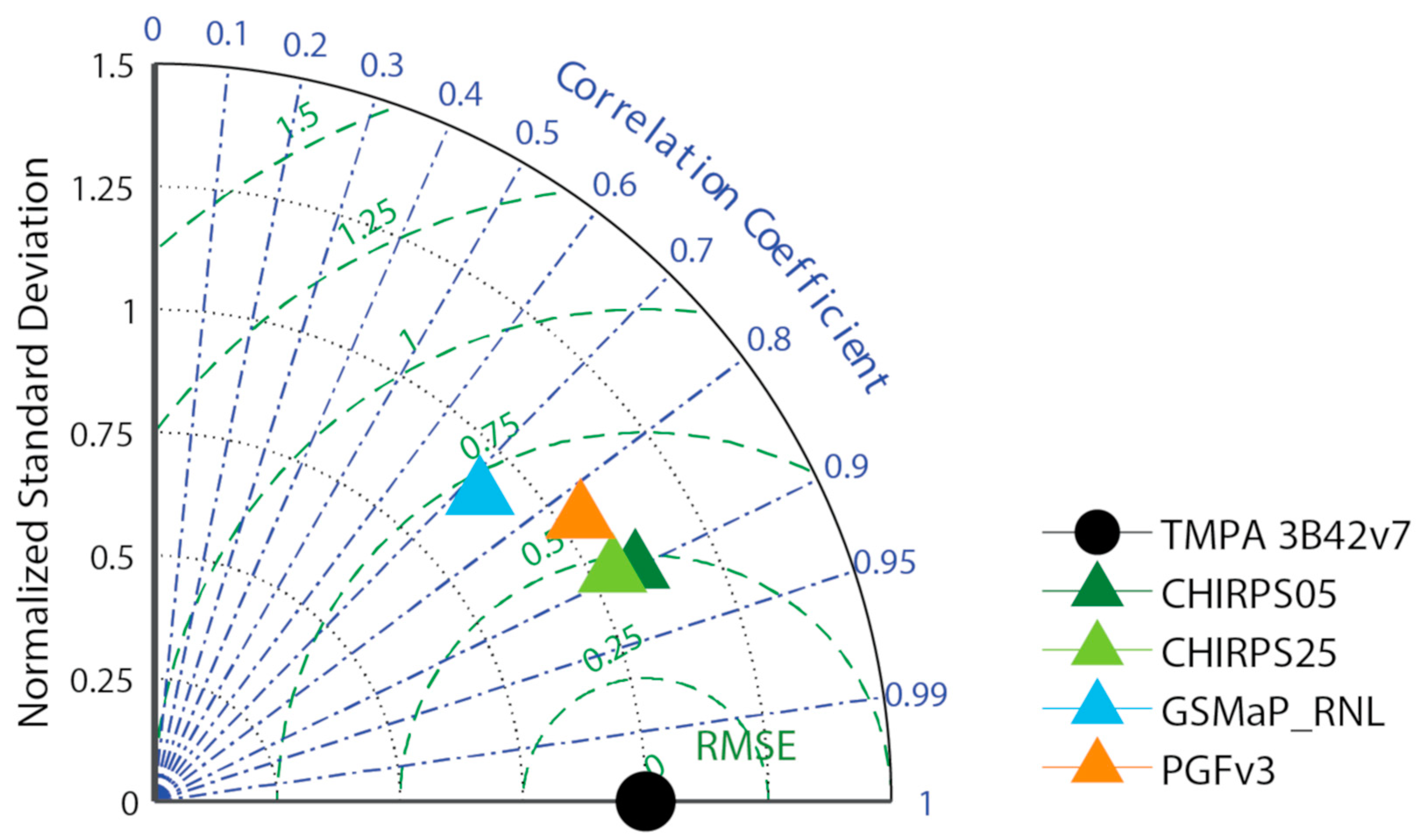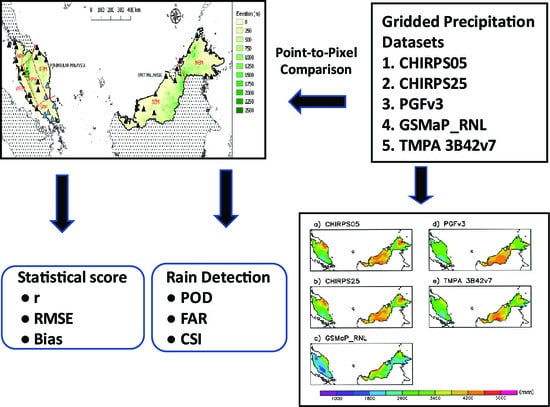1. Introduction
Generally, in most countries, especially the least developed and developing ones, the number of meteorological stations is limited and sparsely distributed. In mountainous and inaccessible areas, there is likely no meteorological station available. Hence, this can be a problem for various applications including validation of weather and climate simulations [
1]. Most applications resort to gridded data derived from satellite products. Since the 1970s, due to their wide spatial and long temporal coverage, satellite-gridded precipitation datasets have been widely used in climate studies [
2,
3]. However, the readily available satellite-based precipitation datasets can have differences in quality, reliability, resolution and spatial-temporal coverage. The quality and reliability of these products can also be influenced by the onboard sensors and algorithms used for rainfall conversion [
4]. For satellite and rain gauge blended datasets, the quality can also be dependent on rain gauge observations and interpolation techniques used to produce the gridded products. Hence, the pre-evaluation of these products prior to application, particularly for climate model evaluation, is necessary [
5,
6].
In Malaysia, despite the availability of various satellite or blended gridded-precipitation data, evaluation studies thus far are incomplete and limited to a few products. Six products have been evaluated including the Tropical Rainfall Measuring Mission (TRMM) [
4,
7], the Global Precipitation Measurement (GPM) [
2], the Global Precipitation Climatology Project (GPCP) [
8], the Precipitation Estimation from Remotely Sensed Information Using Artificial Neural Network (PERSIANN) [
9], the Climate Prediction Center Morphing Technique (CMORPH) [
10] and the Asian Precipitation-Highly Resolved Observational Data Integration Towards Evaluation (APHRODITE) [
11]. Among these products, TRMM has been shown to have the best quality where it has the smallest biases and highest correlation when compared with rain gauge observation [
12,
13,
14]. Other products such APHRODITE, CMORPH and GPM have also been considered as good product in some studies [
14,
15]. However, for extreme rainfalls Soo et al. [
16] found that at basin scale in northeast Peninsular Malaysia, both TRMM and CMORPH showed better quality. In addition, Tan et al. [
15] also showed good performance of TRMM and GPM in approximating extreme rainfalls. Nevertheless, because of its finer resolution (0.1°) and data availability in 30 minutes, GPM could be a better choice for investigation of extreme rainfall during flood events in Malaysia. Overall, the findings of these studies suggested that TRMM and GPM were considered as the most reliable and accurate gridded precipitation data over Malaysia. However, due to its long temporal coverage, TRMM has the advantage over GPM for most applications especially in climate model evaluation.
The reliability of a dataset is also dependent on the temporal resolutions and seasons. Studies found that most products performed well in approximating the annual and monthly rainfall, but less well in the daily values [
14,
16]. In addition, the performance was also dependent on the amount of rainfall and tended to be better during seasons with high rainfall. In Malaysia, rainfall amount tends to peak during the winter monsoon (locally known as northeast monsoon) although spatial variation is also featured [
17]. Hence, the performance of the products can be dependent on location, where better performance is indicated over the eastern and southern parts of Peninsular Malaysia during the northeast monsoon, because of the higher amount of rainfall received in these areas [
12,
14].
A number of other products including the Climate Hazards Group Infrared with station data (CHIRPS) [
18], Princeton Global Forcings (PGF) [
19] and Global Satellite Mapping of Precipitation (GSMaP) [
20] have yet to be evaluated for their quality and reliability over Malaysia. In many places around the world these data products have been investigated thoroughly. CHIRPS, which has the highest spatial resolution of 5 km, has been evaluated in various countries including Ethiopia [
21,
22], China [
23], Brazil [
24], Venezuela [
25], Italy [
26], Vietnam [
27] and Indonesia [
28]. CHIRPS exhibited a good performance in southern China during the warm season [
23], and the performance was less affected by elevation variation at the Upper Blue Nile Basin in Ethiopia [
22]. CHIRPS also approximated well the rain gauge data and its spatial pattern in the south-southeast region of Minas Gerais State, Brazil, although TRMM was of relatively better quality and reliability [
24]. CHIRPS has also been used for extreme indices including drought and flood monitoring in the Lower Mekong Basin [
27], South Sulawesi, Indonesia [
28] and the Haihe River Basin, China [
29]. Both the GSMaP and PGF have also been evaluated in some areas around the globe. In the Haihe River Basin, GSMaP showed good agreement with rain gauge measurements [
30]. In the Karpuz River Basin, Turkey, GSMaP was shown to have reasonable performance in approximating the observation although it has a tendency to underestimate extreme rainfall during flash floods [
31]. However, a study in Singapore found GSMaP has higher uncertainty than TRMM for sub-daily precipitation [
32]. In addition, a study carried out in Adige Basin, Italy found that PGFv3 performance was less reliable compared to CHIRPS and TRMM [
26].
This paper focuses on evaluating the quality and reliability of three gridded precipitation products that have yet to be validated over Malaysia namely CHIRPS, GSMaP and PGFv3 by comparing the gridded data to rain gauge observation data. For comparison, TMPA 3B42v7 will also be included. The evaluation analyses consider spatial as well as temporal variations and possible factors that may contribute to the performances of the products.
5. Discussion
This analysis explored the reliability and quality of five readily available gridded precipitation datasets compared to observed rain gauge data. Consistent with Tan et al. [
14,
15] the result indicated that the TMPA 3B42v7 is the overall best performing gridded precipitation dataset in Malaysia followed by CHIRPS, GSMaP_RNL and PGFv3. These relative performances could be due various factors related to input data, onboard sensors, algorithm, and interpolation techniques (
Table 1). However, it is difficult to attribute and quantify the effects of each factor. The blending of rain gauge data does not guarantee the highest quality of the products. For examples, both TMPA 3B42v7 and CHIRPS incorporated rain gauges (although number of stations used may be different) but the former has been consistently proven to be the best gridded precipitation data in this study and previous investigations [
12,
13,
14,
16]. Hence, other factors such as onboard sensors and algorithm could be more important. However, the performance could vary spatially due the characteristics of the sub-regions, especially in terms of elevation and topography [
1,
48]. In East Malaysia, PGFv3 appears to be a better product than GSMaP_RNL.
The results of the analyses could be least influenced by the number of rain gauges in each sub-region. In particular, with roughly equal number of stations: NPM–6 stations, EPM–6 stations, MPM–5 stations, WPM–6 stations, SPM–5 stations, NEM–5 stations and SEM–8 stations, the total number of stations may not be the dominant factor in determining the performance of gridded products. However, the MPM is the only sub-region with two rain gauges located in mountainous locations: K. Tanah Rata and Cameron Highlands (indicated with green triangles in
Figure 1). The results showed that the gridded product performed the worst in MPM, possibly due to the existence of these two mountainous rain gauges.
Figure 9 depicts the scatter plot of five locations in MPM for TMPA 3B42v7, which the two stations in the mountainous region showed lowest correlation. This relatively poor performance could be due the shortcoming in the satellite algorithm when applied in the highly complex terrain of mountainous areas [
49]. In addition, in mountainous regions, radar signals that hit the surface could return false echoes [
50].
Higher spatial-temporal gridded precipitation data was suggested to be of better quality compared to the lower-resolution product [
4]. However, in this study, the higher resolution of the CHIRPS05 product does not improve much over TMPA 3B42v7. This could be a disadvantage of using the CCD technique which may classify some clouds from satellite signals as cold clouds, when in fact most of them are high clouds with no rainfall activity [
51]. In addition, perhaps remote sensing algorithms used in gridded precipitation datasets play an important role in its performance.
The accuracy of gridded precipitation datasets is also influenced by the seasonality of rainfall in each sub-region (
Table 5). The ability of gridded precipitation datasets in approximating the observed rain gauge data is better during the wet season than the dry season, probably due to the capability of the satellite sensor to detect a convective precipitation system [
15]. However, the PGFv3 does not seem to have the same characteristic in EPM for the period from October through December where the rainfall is considered high (
Figure 3). The scatter plot in
Figure 10 shows that PGFv3 was unable to correlate with station data in November, unlike the TMPA 3B42v7 product in
Figure 11. This could be contributed by the downscaling application of reanalysis of global datasets [
52].
Interpolation techniques within each product may also influence the quality. For example, some products may have better characteristics of precipitation gradient at the edge of the mountains compared with others.
Figure 12 shows the spatial maps of annual rainfall of all products. It appears that the spatial rainfall distribution of TMPA 3B42v7 correlates well with topography with indication of precipitation gradient, both in Peninsular Malaysia and East Malaysia. While similar features are also indicated in CHIRPS and GSMaP_RNL in Peninsular Malaysia, much weak gradient can be seen in PGFv3. Nevertheless, the annual rainfall of GSMaP_RL in WPM and MPM is lower compared with TMPA 3B42v7. In SEM of East Malaysia, the precipitation gradient of GSMaP_RNL appears to be reversed to that of TMPA 3B42v7. In fact, the area of maximum rainfall of TMPA 3B42v7 in SEM was not replicated in GSMaP_RNL. In addition, similar to WPM and MPM, GSMaP_RNL underestimated TMPA 3B42v7 rainfall in northeastern SEM and southern NEM. These differences may be caused by the input data in the products. Using TMPA 3B42v7 as a reference dataset, a Taylor Diagram can be used to provide measures of similarity (in terms of both spatial RMSE and correlation values) among other products (
Figure 13). In terms of correlations, both CHRIPS products have the highest values (0.9) followed by PGFv3 (0.84) and GSMaP (0.73). However, based on RMSE, GSMaP_RNL shows the smallest value although GSMaP_RNL tended to underestimate the rain gauge data (
Table 4) as well as TMPA 3B42v7.
